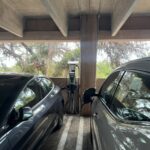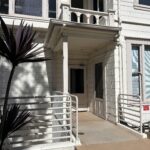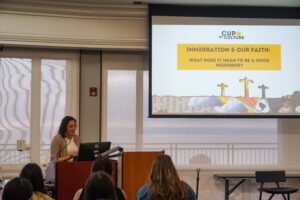With a quick glance around Point Loma Nazarene University’s campus, an outsider could notice — well nothing out of the ordinary actually. Students rush to class down Caf lane, crowd in groups after chapel, sit outside in the sun between classes and are bombarded with free candy during the club and church fairs.
No masks, no lines up the stairs to the Ryan Library lawn for mandatory surveillance testing, no daily symptom check notifications, no makeshift blue tent crowding the door of Point Break with an aggressive “do not enter” sign on the door. All of these routine protocols from the past two years have disappeared. Is the pandemic really over?
It is according to President Biden. In a CBS 60 Minutes interview with Scott Pelley on Sep. 18, 2022, he used those exact words: “The pandemic is over. We still have a problem with Covid. We’re still doing a lot of work on it, but the pandemic is over.”
The significantly reduced number of cases back this claim up. According to the Centers for Disease Control and Prevention’s COVID data tracker, there were 94.75 cases of COVID-19 per 100,000 people in San Diego County as of September 21, 2022. That’s 0.0009475% of the county’s population.
To narrow it down even more, there are currently six active positive cases of COVID-19 on PLNU’s campus out of 5,445 recorded persons, 0.00001102% of the campus population.
PLNU’s Wellness Center Compliance Coordinator, Terrence Knock, commented on the way that the Wellness Center is currently handling the much reduced number of positive cases.
“I believe that we drive discussion in the state and locally that encourages us to focus on a more endemic operating model than the ‘pandemic’ model,” Knock said.
Knock compared the enforcement of mask wearing, which is nonexistent on PLNU’s campus besides in the Wellness Center, to that of other universities in the county. SDSU still requires masks in instructional settings. USD leaves the decision up to the individual professor, and UCSD is still requiring masks in indoor instructional settings.
As a private university, PLNU has had a little more freedom to do whatever it takes to keep students in classrooms as much as humanly, physically and safely possible in the past two years. However, moving forward, Knock emphasized that despite the significantly reduced regulation, the university still has guidelines to follow.
“As much as we would like to believe that we can do what we want as a private school, there are still federal, state, and local health guidelines that we need to meet,” Knock said.
So for any of the few students who may test positive, here is what to expect:
Isolate. Preferably this would happen in a residence off campus, but for students who live on campus, most of the isolation process can occur in their respected residence halls. In fact, students are allowed to stay in their own rooms, with their roommates, without moving to isolation housing.
Knock had an explanation for this form of isolation. “By the time individuals are testing positive, it is five days after they have already exhibited symptoms,” Knock said.
This means that roommates of the individual who tested positive have already been exposed, so they do not need to move locations. They do, however, need to remain masked when they go to the few places they are permitted — the bathroom, the cafeteria, and outside.
Jenna Dougherty, a fourth-year literature English-education major, tested positive in her third week of school, and experienced isolating under these requirements. She equated her experience to Nathaniel Hawthorne’s “The Scarlet Letter.”
“My first frustration was definitely going to the cafeteria. POV: You are fatigued, you are looking like you have not showered, and you actually have COVID-19, but you are casually walking around with gloves on and an N95 mask. And you have to get your own food. It just felt very odd,” Dougherty said.
Although she appreciated the more relaxed COVID-19 regulations, Dougherty felt bad being around people in the Caf and in her dorm bathroom.
“I was isolated in the dorm, which also felt really cursed,” said Dougherty. “I did not want to be inside the Goodwin rooms, in some bare room, but at the same time, when I went and got water, I would be around people. When I went to the Caf, I would be around people. When I went to the bathroom, I would be around people, wearing a mask.”
Other than a few long stares and more distance than usual, Dougherty had a relatively straightforward experience being isolated.
“People who experienced [COVID-19 isolation] last year were so sympathetic to me. But it was not that bad,” Dougherty said.
Besides the few who may be wandering around with masks due to COVID-19 or COVID-19-like symptoms, PLNU, under current reduced COVID-19 cases and state regulations, is now a virtually maskless campus.
For individuals experiencing COVID-19 symptoms or exposure to COVID-19, head to Symptomatic Urgent Care, open from 7:30 a.m. to 1 p.m Monday through Friday, and located on top of the Ryan Library in the white buildings.
To report symptoms, contact the Wellness Center by emailing Covid19wellness@pointloma.edu or calling at (619) 849-2280. Medical care is available Monday through Friday 8 a.m. to 4 p.m. and COVID-19 antigen home test kits are also available for purchase in the Wellness Center.
Written By: Sofie Fransen







